Riding the NASCAR wave: the last 10 years of stock car racing on the NASCAR tour have been historic
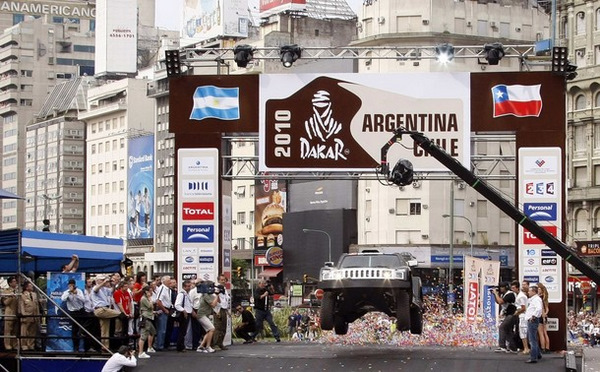
While his NASCAR rivals rest up for the 2010 Sprint Cup season, Robby Gordon is leaping into the new year, with another run in the Dakar Rally. Now what part of Argentina is Dakar.....(Photo: Robby Gordon)
By Mike Mulhern
mikemulhern.net
So now as the second decade of the Third Millennium opens, a brief look back at how we got to where we are….which may help us figure out just where the sport of NASCAR racing is, in fact, at the moment, with the 2010 Sprint Cup season just a few weeks away
And it is almost too neat the way that the major points of the last 10 years can be laid out, in 10 distinct, if huge, chapters.
Was the NASCAR decade just past an era of big races or big events? Of big names, big stars, or significant storylines?
Yes, the key names we all know. That's a good thing about NASCAR – just enough name-stars to keep easy track of (though there are still too many important and powerful figures back in the shadows).
But we here at mikemulhern.net are looking more at the major trends in this sport, the major issues, than the names who play out the various roles, the people who surf these waves.
And here is our take on the great stories and major issues the men and women of the NASCAR world have watched unfold over the past 10 years.
Has it really been almost 10 years since Dale Earnhardt's brilliant charge to victory at Talladega – from 18th to victory circle in the last five laps?
The two most powerful team owners in NASCAR are Chevy's Rick Hendrick and ......
Number 10, on mikemulhern.net's 10 biggest of the decade:
The rise of the super-teams, the mega-teams….and the virtual extinction of the small, independent teams…and the decline and fall of once-great stock car racing operations like Petty Enterprises and the Wood brothers.
Rick Hendrick, Jack Roush, Joe Gibbs, Richard Childress, Roger Penske and Chip Ganassi are the sport's big guns today.
What can little guys like independent Robby Gordon do in battle against such horsepower? The car-of-tomorrow hasn't leveled the playing field; it's put a premium on high-dollar technology and engineering….and on Detroit favorites.
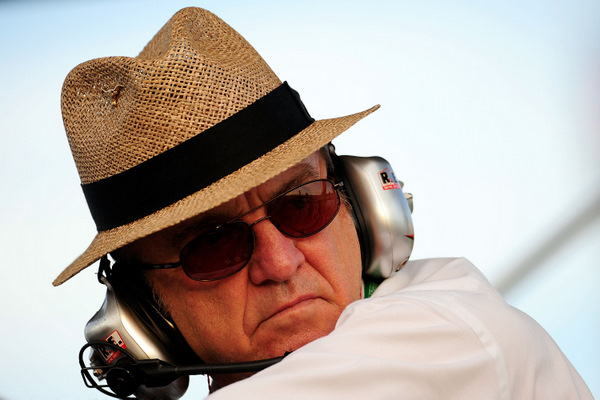
...Ford's Jack Roush (Photos: Getty Images for NASCAR)
Number nine:
Dodge's return to NASCAR after so long on the sidelines…and Toyota's decision to jump into the game too.
Dodge picked a good one in Ray Evernham, who had a great game plan, which unfortunately went awry. And Dodge itself, well, that's a sad story too.
Toyota's move into NASCAR was extremely well thought out (though Michael Waltrip's first season as owner-driver didn't quite go as expected), by deciding to help bring new teams into this sport, rather than simply steal teams.
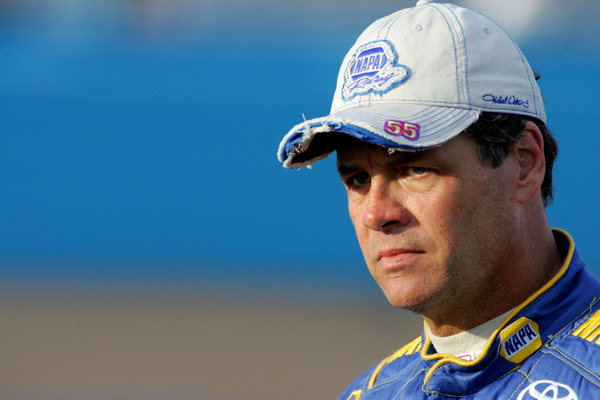
Michael Waltrip: newcomer Toyota gave him a chance to be an owner-driver. What will Waltrip make of it in 2010? (Photo: Getty Images for NASCAR)
Number eight:
Likewise -- The precipitous decline of Chrysler-Dodge and General Motors, the bankruptcies, still all unfolding, with yet unforeseen implications for many NASCAR teams.
And what to make of the rush to green – what does it really mean, and how long will it really last?
Is Ford right in banking on muscle, those 427s?
Or will GM's hydrogen-powered cars and Toyota's hybrids be the wave of the future?
And what does that all mean for NASCAR?
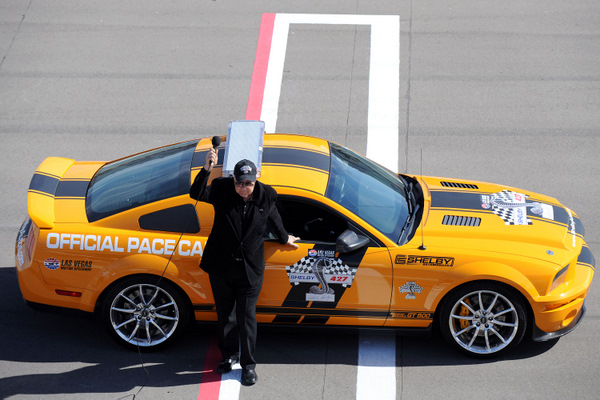
So what do YOU want: green, or fast -- like one of Carroll Shelby's 427s? (Photo: Getty Images for NASCAR)
Number seven:
All the new drivers! Carl Edwards, Kurt Busch, Kyle Busch, Dale Earnhardt Jr., Juan Pablo Montoya, and of course Jimmie Johnson….remember Carl's dramatic victory over Jimmie at Atlanta in 2005. That's one of my favorite race finishes of the decade.
And of course there was Dale's Jr.'s move from Dale Earnhardt Inc. to the Rick Hendrick camp….and all the angst and heartache that's brought. (Curious: where is Teresa Earnhardt at the moment? Since her husband's death she all but vanished from the public eye, except for rare appearances. And she's declined media interviews for years. Now DEI itself is all but history, a museum on the backroads.)
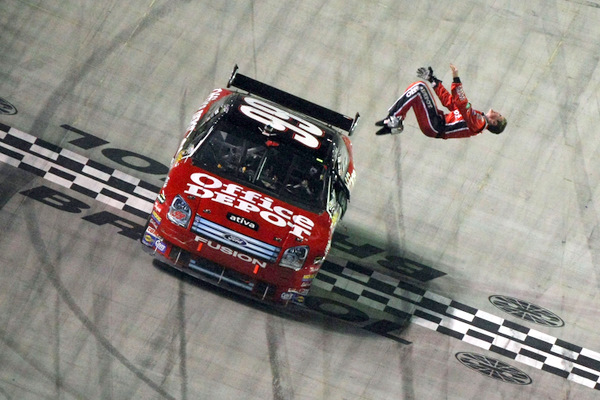
Carl Edwards' signature victory backflip (Photo: Getty Images for NASCAR)
Number six:
The dominance of Jimmie Johnson and Tony Stewart. The torch was passed, and these two guys grabbed it. The 1990s were the great years of the Jeff Gordon-Dale Earnhardt battles….and while Gordon certainly hasn't vanished from the scene -- he probably should have won his fifth championship in 2008, and he was tight in the hunt in 2009 – he has been overshadowed by teammate Johnson, and this past season even ageless teammate Mark Martin.
NASCAR's top two drivers of the last 10 years? Tony Stewart (L) and Jimmie Johnson, perhaps. (Photo: Getty Imges for NASCAR)
Number five:
The emergence of so many new NASCAR tracks in so many new markets.
Kansas City, Homestead-Miami, Chicago, Las Vegas…even Mexico City and Montreal...though NASCAR execs seemed a bit too nervous to take the full Cup tour there. But the Southern 500 being moved from Darlington to Los Angeles? And then over to Atlanta? The LA 500: Ill-timed, ill-fated, and a move a lot of veteran NASCAR fans didn't like. In fact some long-time fans got a little upset with NASCAR's expansion, and what some perceived as a look-askance at the sport's traditions.
The other half of this story -- the general boring races at all these tracks, lackluster at best. Is there a Kansas City race that really stands out, from start to finish (yes, the Carl Edwards' wall-shot was a good finish, but what about the racing itself?) Or Chicago?
Homestead-Miami, after the latest repaving design, is finally starting to come around, and Vegas too. But for most of the decade the races at these new venues were less than memorable. (And don't even get me started on that 14-degree-banked problem track in Fontana, Calif.)
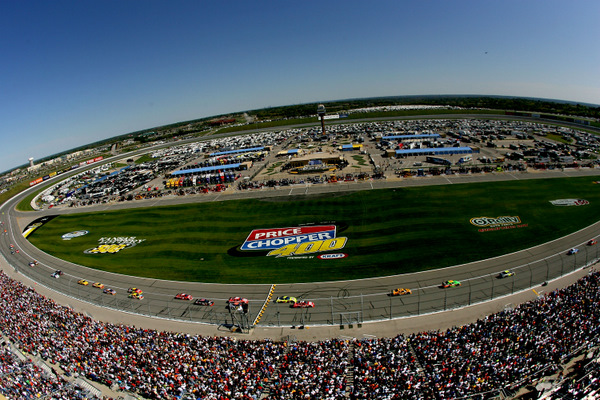
NASCAR added a lot of very nice speedways over the past decade, like Kansas City, one of the coolest stops on the tour. But how memorable, really, is the racing? (Photo: Getty Images for NASCAR)
Number four:
The death of Bill France Jr., and the end of an era.
Yes, he'd turned the reins over, but while he was still around to offer wisdom, the sport seemed somehow more in control of its destiny.
Without him, well, that's been quite a story of controversy.
Just like there was only one Bill Sr., there was only one Billy Jr.
And how Brian and Jim and Lesa handle things, well, that's been ripe for debate; they're still facing great challenges in living up to Billy Jr.'s expectations.
Jim France, the man who owns majority interest in this sport, is a great guy, with a lot of Billy Jr.'s eye for commonsense about things; however, he's been too shy and retiring over his career, preferring to play his role in the wings, rather than centerstage.
Lesa France Kennedy, Brian's sister and Bill Jr.'s daughter, has likewise been shy about stepping to the fore, though she owns a sizeable chunk of the sport and is head of the family's track real estate operations.
Which leaves Brian France, 47, on the point. And while Brian's almost imperial presence may work well in the boardrooms of America, making those hard-nosed deals, his public persona may need a little PR polishing. And Brian, just a few years back, made it clear he wasn't really interested in hanging on in this sport for 30-plus years like his legendary father did. Is there really a Los Angeles NFL team in Brian's future?
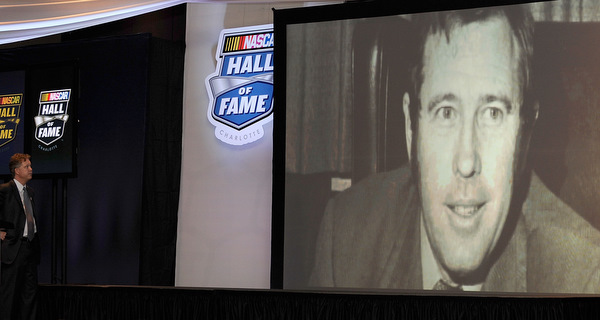
Billy France Jr., indeed larger than life at times. (Photo: Getty Images for NASCAR)
Number three:
Brian France's Great TV Charge, putting the sport on the big networks, Fox and NBC, beginning in 2001.
That built on a 20-year foundation built by once-gritty ESPN (which has become just a little too glitzy and, well, uppity, since returning to NASCAR, as some see it).
And when NBC decided to bail out, France got ABC-ESPN to fill the void (controversy, controversy, controversy – this sport just thrives on it, doesn't it?). Now ESPN has become a point of controversy itself (and not just in NASCAR), because of its almost monolithic sports status. Is there any other TV sports power that can challenge multi-tentacled ESPN? Has ESPN, this 800-pound gorilla, become just too big for its britches? (And isn't there a sense that Fox' David Hiill may have gotten a little bored with this NASCAR thing?)
The big New York TV guys changed the sport – just we all anticipated…only in some ways we didn't foresee. How in the world did all those race-starting times get so screwed up? Will going back to more standard help the sport, or not?
NASCAR CEO Brian France and wife Amy, at the Las Vegas awards banquet. (Photo: Getty Images for NASCAR)
The first five years of the new TV deal, NASCAR's ratings soared, more than anyone could have expected.
So is the current decline in ratings merely the sport reaching its equilibrium, or something more serious?
And a big part of this storyline is the precipitous collapse of America' great print media world over the past three or so years. Too many of the country's major newspapers have killed off so many coverage beats and fired so many reporters that most papers have become little more than local 'shoppers.' The NASCAR world has lost virtually every major beat reporter, in a wholesale media slaughter. And then the death of Charlotte's David Poole, one of this sport's most prominent journalists, back in the spring, was almost the coup de grace for NASCAR-print. Even the few papers that still pretend to have a NASCAR 'beat' have cut coverage dramatically. And the Associated Press has been taking a beating too (the AP's full-time NASCAR writer is only covering 25 of the tour's 36 events).
All that may have in fact had a major impact on NASCAR's TV numbers. There once was a synergy between print and electronic. But now it's all about the 'net, which is still a Wild Wild West.
Thus, certainly the opening months of 2010 will be filled with media drama – some behind the scenes, for sure, and some right out front (can you spell Danica?) – as the sport and its bosses and teams try to pump up those ratings.
The late February stop in Los Angeles and the next weekend's stop in Las Vegas, followed by Atlanta, those may be three critical events for this sport…along with the April races in Dallas-Fort Worth and Phoenix.
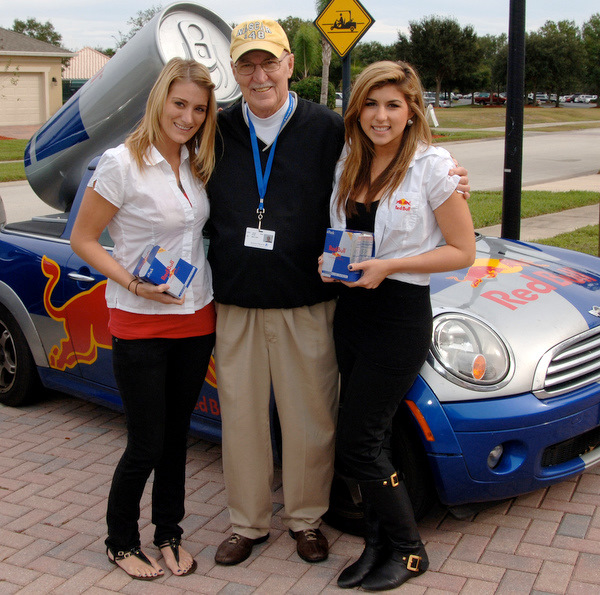
Jim Hunter, as NASCAR's consigliere, the power behind the throne. (Pass the Red Bull eggnog, please.) (Photo: Getty Images for NASCAR)
Number two:
R. J. Reynolds' abrupt and unexpected withdrawal from marketing-sponsorship-and-promotion of NASCAR, after more than 30 years helping the France family – in one of American sports' greatest-ever, and most successful, synergies.
RJR announced its plans to pull out in the summer of 2003, and Matt Kenseth became last Winston Cup champion.
NASCAR turned to Nextel as its next series sponsor, with high hopes, but that company has had issues of its own, finally merging with Sprint. And for the past few years (since the turnover of virtually all the Nextel men who helped broker the NASCAR deal) the cell phone company has seemed strangely distant from the sport itself…in stark contrast to RJR's intimate relationship with NASCAR and its drivers and teams and executives.
With what looks like a major demographic chasm growing in this sport, many fans now may forget not only the legendary Dale Earnhardt but also that RJR (and General Motors) almost kept NASCAR alive on live support in the 1970s.
The addition of live wire-to-wire coverage of just about every tour event in the 1980s – the sport began to thrive again. Credit R. J. Reynolds' Jerry Long for helping NASCAR nurture that venture.
But times change, and Big Tobacco found the politics of it all too trying, and bailed out. Still, it is somewhat shocking even now that a company that had invested 33 years and so much in a sport, to raise it to such national prominence, would so suddenly call it quits.
And the sport, in a sense is still trying to deal with the aftermath of that, particularly at racing's grassroots level, where the RJR influence was so important, if still somewhat unrecognized.
Why Nextel/Sprint execs – whoever they are now -- haven't moved their NASCAR promotions to the local levels around the country, like Reynolds did, is one of NASCAR's great mysteries.
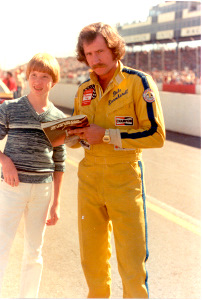
Legendary Dale Earnhardt, 1979, before his first NASCAR Winston Cup tour win....and 2000, after winning that dramatic Winston 500 at Talladega (Photos: NCrozier and Getty Images for NASCAR)
And the number one NASCAR story of the first decade of the new millennium on mikemulhern.net:
Dale Earnhardt's death in 2001, the stunning national response, and NASCAR's ensuing massive safety initiatives, excellent work, some points even brilliant, which has made such an amazing change in the sport, and not just in NASCAR.
It is such a huge story that is even now still evolving – the flipping crashes at Talladega last season, Jeff Gordon's hard hit at Las Vegas, at an odd part of that track, every time there is a bad crash, drivers can thank NASCAR's dedication to safety.
Soft walls? Who would have thunk? The HANS…more attention to the driver's cockpit area (credit GM and Ford for a lot of crucial work here)…Steve Peterson's tireless and head-strong safety work for NASCAR as its safety director; his untimely death, at just 58, in the summer of 2008 left a major void.
Yes, that car-of-tomorrow may have been, in a sense, overkill in safety. And it certainly doesn't really drive all that well yet. But it's a life-saver. And the ideas the COT has in it will be incorporated in future versions…which drivers and crew chiefs – and some major track promoters -- would like to see coming down the pike pretty darned soon.
And that's the way it is, January first of the second decade of the new millennium.
We can't wait to see what tomorrow brings to NASCAR.
[Note: You can use Twitter as an easy headline service for mikemulhern.net stories, with our instant Tweets to your mobile as soon as our newest NASCAR story is filed. You can also use the orange RSS feed button as a quickie headline service on your laptop or home computer for mikemulhern.net stories, by creating a Live Bookmark RSS feed on your web browser's toolbar.]
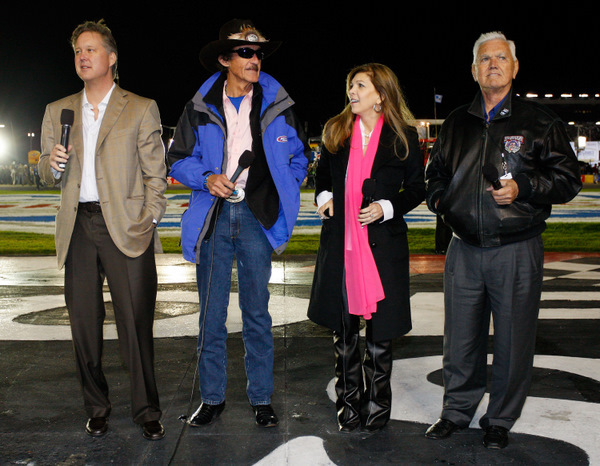
NASCAR: It's not only about Yesterdays but also about Tomorrows. But then 'What's past is prologue,' isn't it...hopefully. (Photo: Getty Images for NASCAR)
© 2010-2011 www.mikemulhern.net All rights reserved.
Web site by www.webdesigncarolinas.com







A fond look back
What a great story... I'd somehow forgotten that all those things happened in a very brief passage of time. Thanks, Mike!
Post new comment